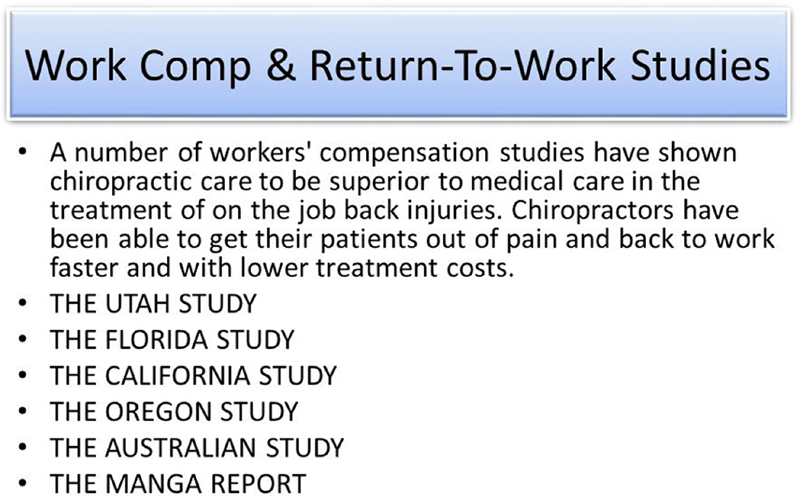Who Will Have Sustainable Employment After a Back Injury? The Development of a Clinical Prediction Model in a Cohort of Injured Workers
SOURCE: J Occup Rehabil. 2017 (Sep); 27 (3): 445–455
Heather M. Shearer, Pierre Cote, Eleanor Boyle, Jill A. Hayden, John Frank, William G. Johnson
UOIT-CMCC Center for the Study of Disability Prevention and Rehabilitation,
University of Ontario Institute of Technology,
2000 Simcoe St. North,
Oshawa, ON, L1H 7K4, Canada.
Our objective was to develop a clinical prediction model to identify workers with sustainable employment following an episode of work-related low back pain (LBP).
Methods We used data from a cohort study of injured workers with incident LBP claims in the USA to predict employment patterns 1 and 6 months following a workers’ compensation claim. We developed three sequential models to determine the contribution of three domains of variables:
(1) basic demographic/clinical variables;
(2) health-related variables; and
(3) work-related factors.
Multivariable logistic regression was used to develop the predictive models. We constructed receiver operator curves and used the c-index to measure predictive accuracy.
Results Seventy-nine percent and 77 % of workers had sustainable employment at 1 and 6 months, respectively. Sustainable employment at 1 month was predicted by initial back pain intensity, mental health-related quality of life, claim litigation and employer type (c-index = 0.77).
There are more articles like this @ our:
The RETURN TO WORK Section and the:
At 6 months, sustainable employment was predicted by physical and mental health-related quality of life, claim litigation and employer type (c-index = 0.77). Adding health-related and work-related variables to models improved predictive accuracy by 8.5 and 10 % at 1 and 6 months respectively.
Conclusion We developed clinically-relevant models to predict sustainable employment in injured workers who made a workers’ compensation claim for LBP. Inquiring about back pain intensity, physical and mental health-related quality of life, claim litigation and employer type may be beneficial in developing programs of care. Our models need to be validated in other populations.
KEYWORDS:   Back injuries; Employment; Return to work
From the FULL TEXT Article:
Introduction
Low back pain (LBP) is the highest contributor of global disability worldwide. [1] In the UK in 2009, the direct health care costs of chronic back pain exceeded £1.5 billion. [2] Occupational back pain is associated with significant direct and indirect costs to employers, insurers, and injured workers. [3] In 2013 in the United States, the incidence of back pain injuries among full-time workers was 20 per 10,000. [4] Additionally, back problems were ranked seventh for annual average cost of productivity loss (absenteeism and presenteeism) among employed workers with health reimbursement accounts. [5] A median of seven days away from work to recuperate from a back injury was reported in the United States in 2013. [4]
Previous studies suggest that back pain is episodic and is associated with recurrent work absenteeism. [3, 6, 7] Additionally, individuals with prevalent back pain are more likely to report future back injuries, work absences, and more comorbidities compared to workers with incident LBP. [8] Although we have gained knowledge about the outcomes experienced by injured workers with back pain, we still lack the ability to accurately predict who is more likely to regain sustainable employment. Therefore, it is important to develop clinical prediction models to predict outcome following a work-related back injury.
A challenging issue facing clinicians is to predict, shortly after the injury, the probability of returning to sustainable employment. Clinicians often rely on clinical experience and clinically relevant scientific evidence to determine the prognosis of a patient. Very few prediction models clearly identify who is likely to return to work and maintain sustainable employment following an occupational low back injury. Several studies have proposed prediction rules to identify workers at risk of chronic work disability; however, their predictive ability is low, ranging from 12 to 30 %. [9–11] Additionally, many models do not include important prognostic factors for work disability. [12] A literature review of predictive models and rules used to determine persisting functional restrictions in individuals with sub-acute LBP, reported the predictive ability of existing models was moderate at best (explained variance ranged from 28 % to 51 %). [13] The objective of our study was to develop a clinical prediction model to identify individuals with sustainable patterns of employment 1 and 6 months after a low back work injury.
Read the rest of this Full Text article now!





Leave A Comment